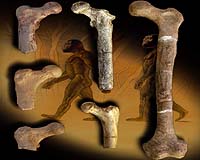| . |  |
. |
Washington DC (SPX) May 25, 2010 Azendohsaurus just shed its dinosaur affiliation. A careful new analysis of A. madagaskarensis - this time based on the entire skull rather than on just teeth and jaws - aligns this 230-million-year-old animal with a different and very early branch on the reptile evolutionary tree. Many aspects of Azendohsaurus are far more primitive than previously assumed, which in turn means that its plant-eating adaptations, similar to those found some early dinosaurs, were developed independently. The new analysis is published in the journal Palaeontology. "Even though this extraordinary ancient reptile looks similar to some plant-eating dinosaurs in some features of the skull and dentition, it is in fact only distantly related to dinosaurs," says John J. Flynn, curator in the Division of Paleontology at the American Museum of Natural History. "With more complete material, we re-assessed features like the down-turned jaw and leaf-shaped teeth found in A. madagaskarensis as convergent with some herbivorous dinosaurs." The fossil is a member of Archosauromorpha, a group that includes birds and crocodilians but not lizards, snakes, or turtles. The type specimen of the genus Azendohsaurus was a fragmentary set of teeth and jaws found in 1972 near (and named for) a village in Morocco's Atlas Mountains. The fossils on which the current research paper is based was discovered in the late 1990s in southwestern Madagascar. Named A. madagaskarensis, this specimen was uncovered by a team of U.S. and Malagasy paleontologists in a "red bed" that includes multiple individuals that probably perished together. This species was initially published as an early dinosaur in Science over a decade ago, but the completeness of the more recently unearthed and studied fossils has provided the first complete glimpse of what this animal looked like and was related to. A. madagaskarensis was not a dinosaur. A. madagaskarensis lived during the period of time that dinosaurs, crocodile relatives, mammals, pterosaurs, turtles, frogs, and lizards were getting their start, and all of the continents were connected as the supercontinent Pangaea. A. madagaskarensis was 2 to 4 meters long and weighed between 20 and 50 kilos (about 44 to110 pounds). A. madagaskarensis was an efficient herbivore-"a veritable four-legged weed-whacker," according to Flynn-with teeth modified for slicing vegetation covering not only its jaws, but also the roof of its mouth. Even though early archosaurs were commonly thought to be primarily carnivorous, A. madagaskarensis shows that traits associated with herbivory were much more widespread across archosaur reptiles. "Now there are many more cases of herbivorous archosaurs," says Andre Wyss, professor at the University of California, Santa Barbara. "We are rethinking the evolution of diet and feeding strategies, as well as the broader evolution of the group." "This is the way science works," says Flynn, commenting on the reinterpretation of the fossils. "As we found and analyzed more material, it made us realize that this was a much more primitive animal and the dinosaur-like features were really the product of convergent evolution." Wyss adds, "In many ways Azendohsaurus ends up being a much more fantastic animal than if it simply represented a generic early dinosaur."
Share This Article With Planet Earth
Related Links American Museum of Natural History Darwin Today At TerraDaily.com
 Possible New Class Of Supernovae Puts Calcium In Your Bones
Possible New Class Of Supernovae Puts Calcium In Your BonesBerkeley CA (SPX) May 25, 2010 In the past decade, robotic telescopes have turned astronomers' attention to scads of strange exploding stars, one-offs that may or may not point to new and unusual physics. But supernova (SN) 2005E, discovered five years ago by the University of California, Berkeley's Katzman Automatic Imaging Telescope (KAIT), is one of eight known "calcium-rich supernovae" that seem to stand out as hors ... read more |
|
| The content herein, unless otherwise known to be public domain, are Copyright 1995-2010 - SpaceDaily. AFP and UPI Wire Stories are copyright Agence France-Presse and United Press International. ESA Portal Reports are copyright European Space Agency. All NASA sourced material is public domain. Additional copyrights may apply in whole or part to other bona fide parties. Advertising does not imply endorsement,agreement or approval of any opinions, statements or information provided by SpaceDaily on any Web page published or hosted by SpaceDaily. Privacy Statement |